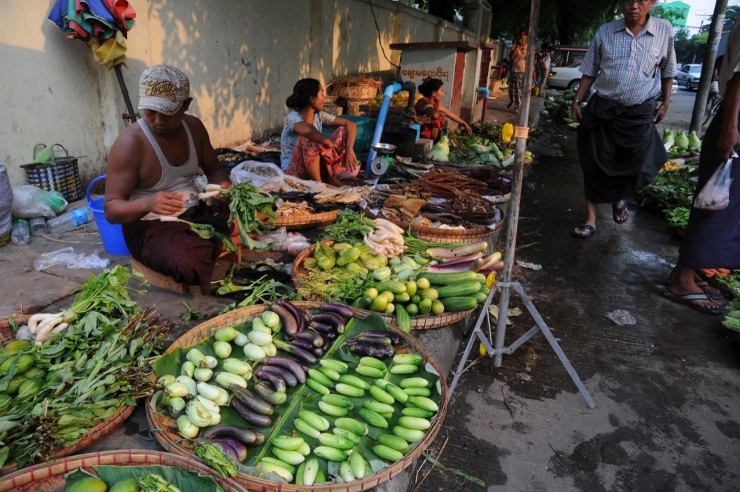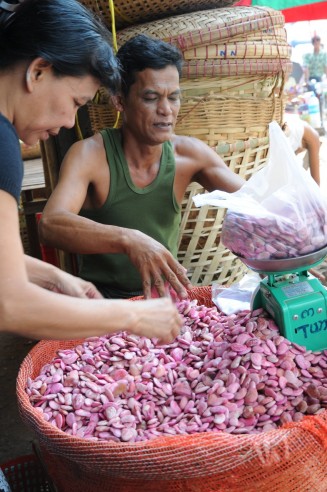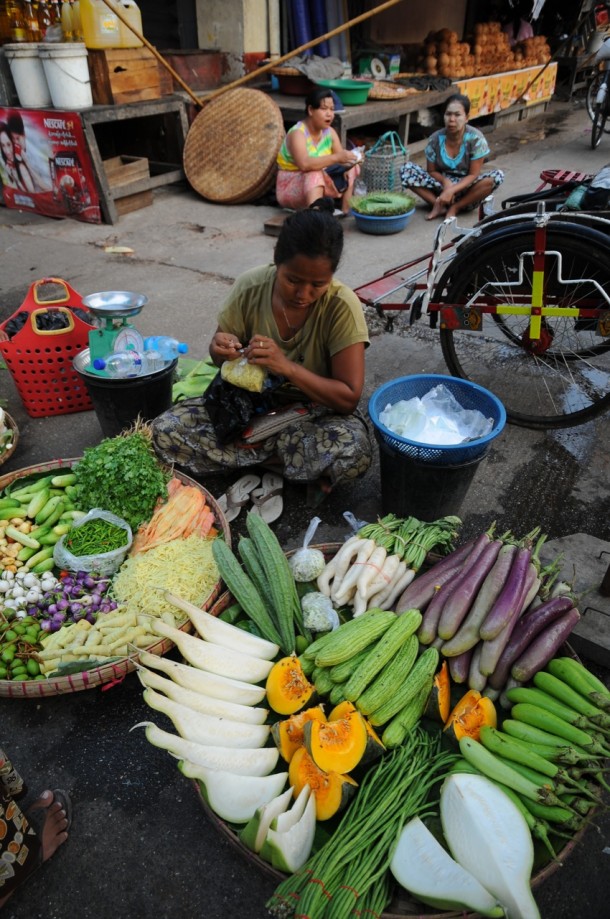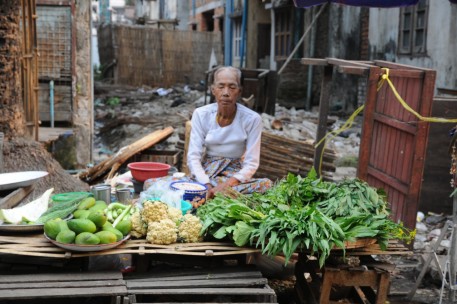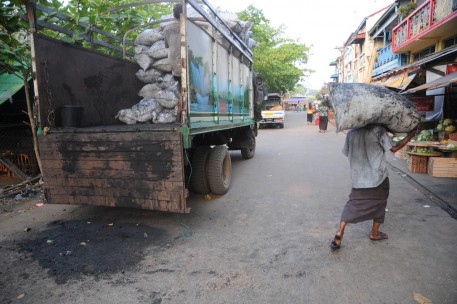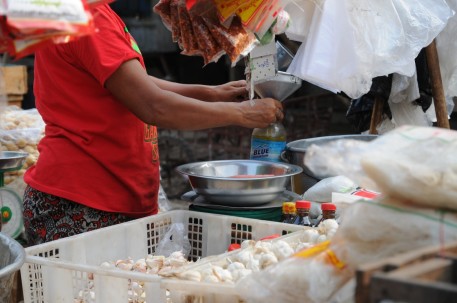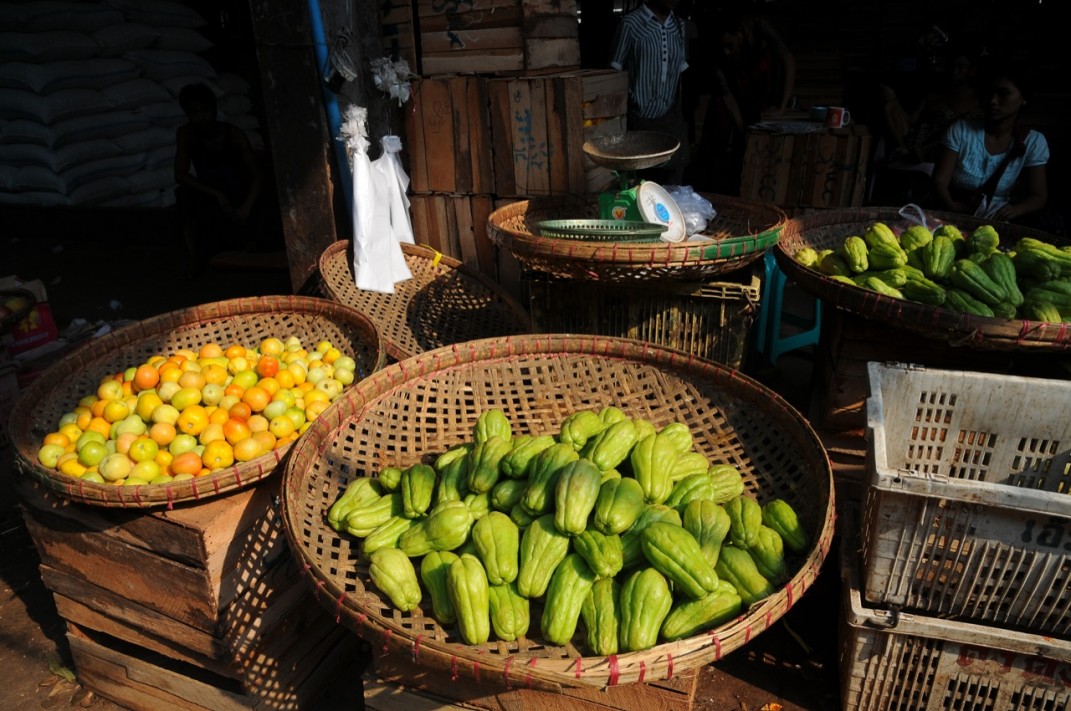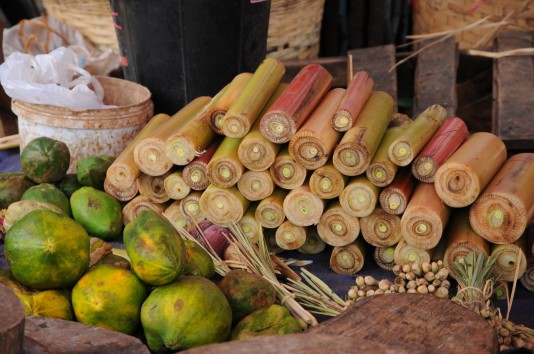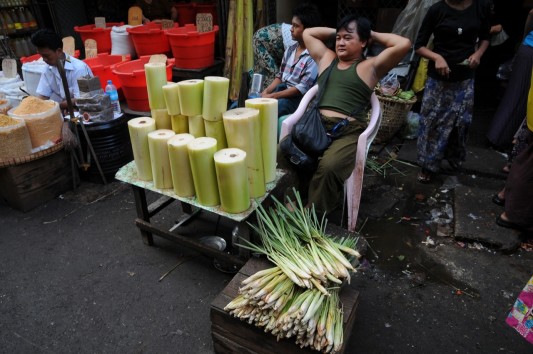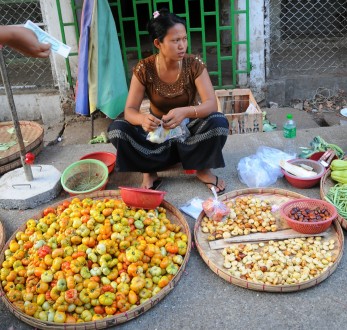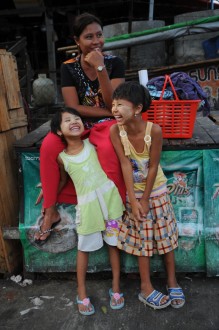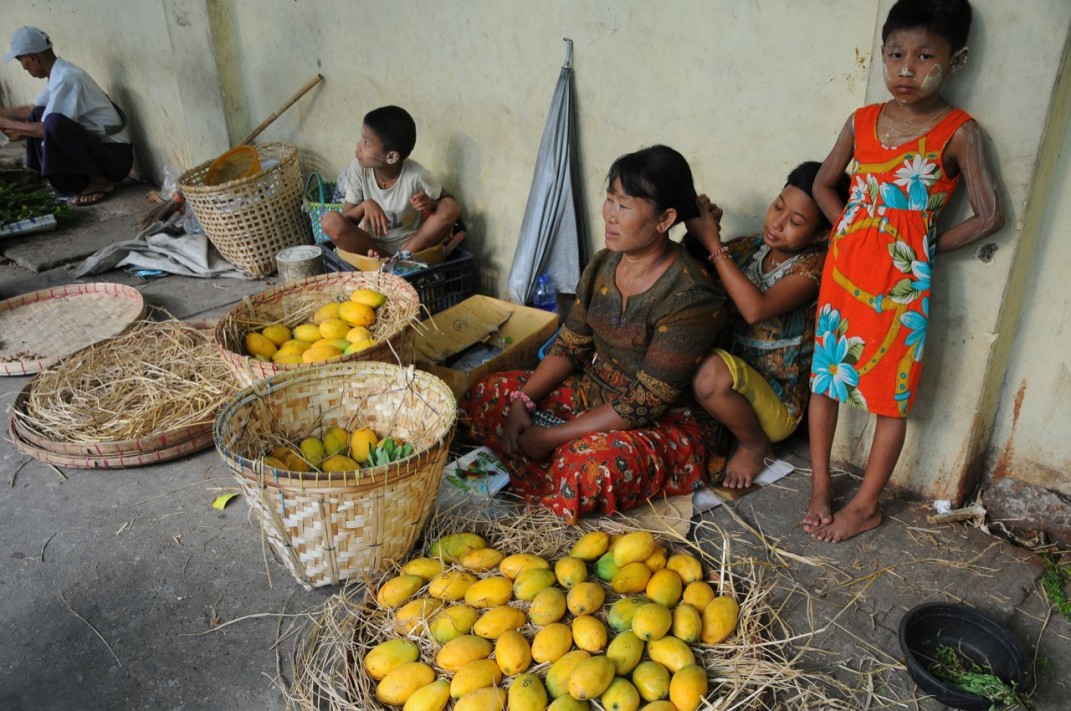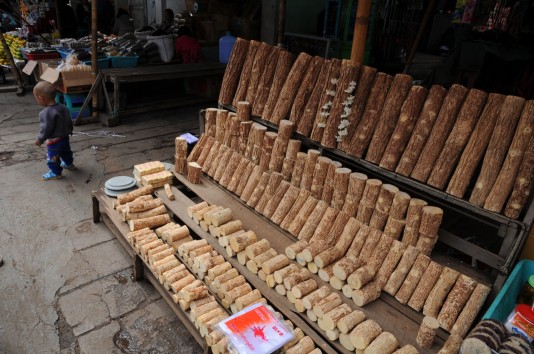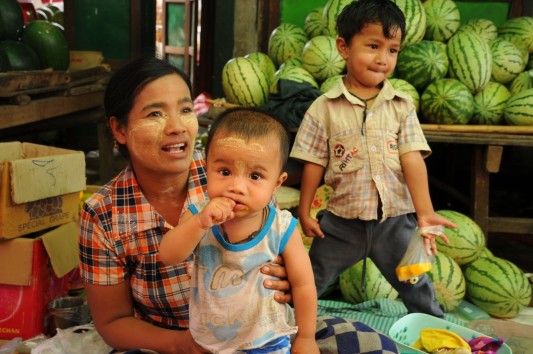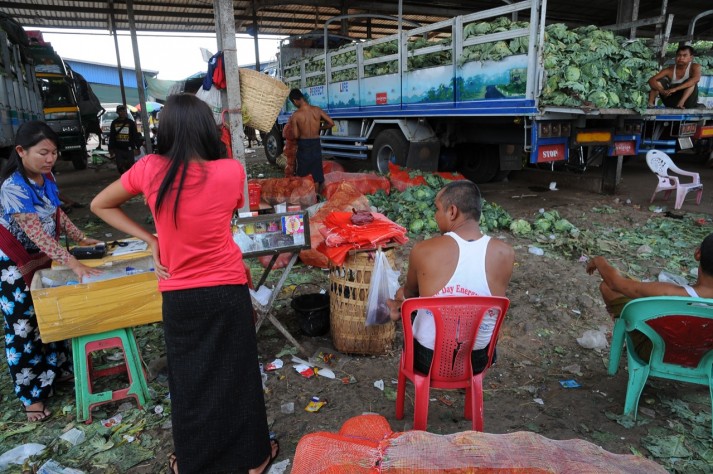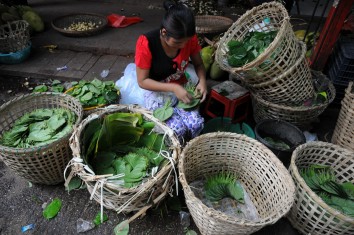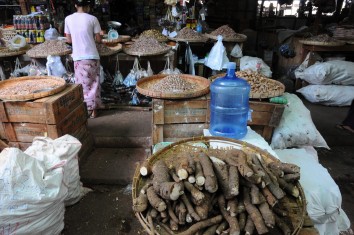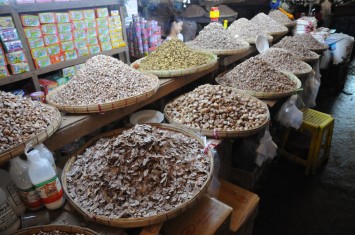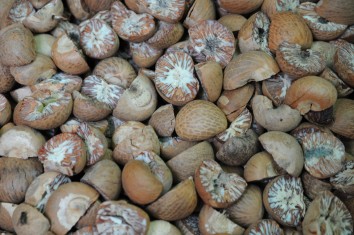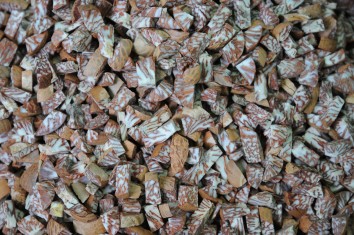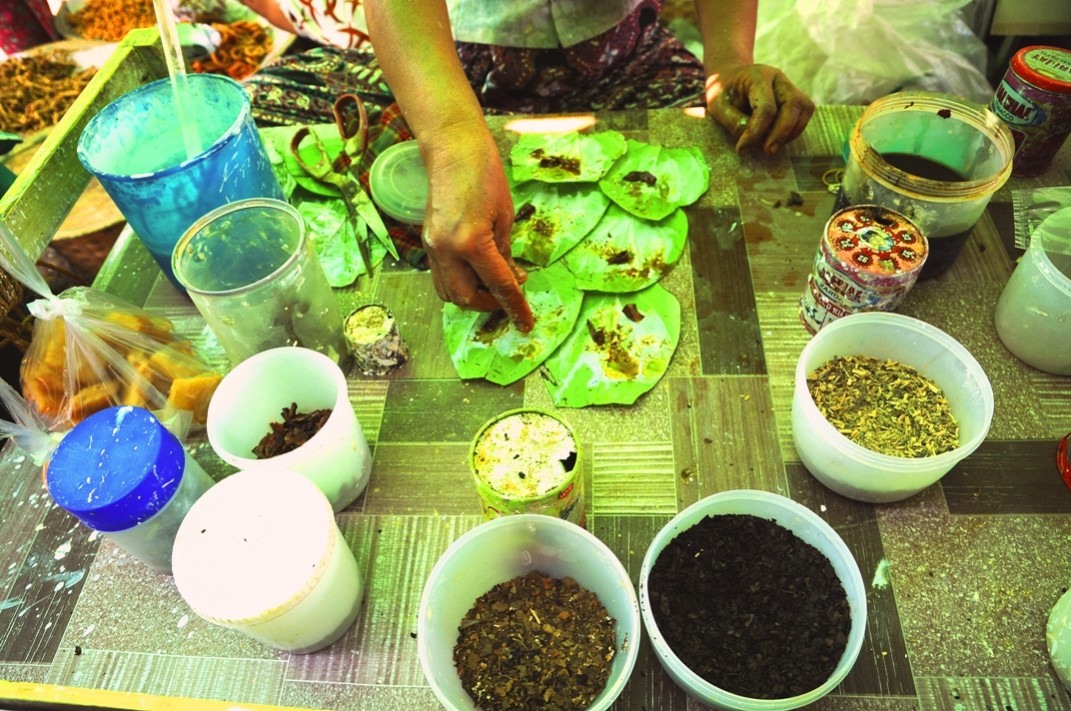The food reflects the Burmese culture and habit(see “The Taste of Myanmar”)and the traditional market also demonstrates the local people’s daily life. After all, people need to get what they need (firewood, rice, oil, salt, soy sauce, vinegar and tea leaves) in the market. We can see the relations and the business transaction between different people in the local market.
Pazundaung Zay- Small Market in the East of Yangon
In Burmese, “Zay” means the market. After we settle down at the hostel in Yangon in the first day, we visit Pazundaung Zay , a small retail market selling fresh vegetable and meat located along the riverside in the east of Yangon. We do not see any foreigner in this market. A Chinese man like me with the white complexion (instead of the local Burmese’s dark complexion), wearing long pants (instead of the longyi that the local Burmese male labour tends to wear), and a black and huge single-lens digital camera around the neck is too distinguished to hide the identity to stroll around the market.
The market is still very crowded after 12 o’clock. The major population strolling around the market is female. Women wearing the bamboo basket pick up and try the product, look around, complain the quality but still pick up what they want and bargain the price. It is quite common. Every mother is the same. Pazundaung Zay is very similar to other Asian markets. The market center is located in a main building and around the building, the street stands sell fresh vegetable and meat. When we walk around the market, we can see many vegetable, fruit and ground provisions. We can tell that most of street stand owners get their product from the central market. Along a narrow alley, there are many vegetable and fruit stands and the width of path only allows a person to walk through. There are many vegetable varieties in this dry season- aubergine, broccoli, pumpkin, sweet potato, water convoevueus, okra, cabbage (with thick leaves), cucumber, pea, asparagus, luffa, Chayote, beetroot, sweet corn, bitter squash, hot pepper chili, broad bean, Chinese chive, leek, ginger, garlic, taro, mint, bamboo, basil, carrot, and tamarind.
Roselle leaves, Ngat-Byor-Ou, sour tomato and Sen Da lone
Roselle leaves, Ngat-Byor-Ou, sour tomato and the best mango Sen Da Lon attract my attention in the market. TaiTung is famous for roselle growth in Taiwan. Taiwanese tend to use dry calyx to make the tea or produce the preserved fruit and jam. But Burmese will use the purple leaf-stem of roselle leaves to fry with minced shrimp, shrimp or fish pungent paste, chili pepper, onion, garlic, bamboo, malvaceae plants in the tropical area and fish from Bay of Bengal. This is the famous Burmese dish “Chin Baung Kaw” at Town of Gourmand, Moulmein. The first time I saw the roselle leaves was in the market at Hwa-Shin Street, Chung-Ho District, New Taipei City. Now I finally see the source of this food culture in Yangon. The first time I experienced Ngat-Byor-Ou was at the restaurant “Mummy Gong Mohinga” in Hwa-Shin Street. Rice noodle with crispy Ngat-Byor-Ou, fried onion or fried peas and poured with the rich fish stock. This is the traditional breakfast in Yangon- mohinga. Before I left for Myanmar, Mrs. Gong reminded me for the high temperature and the way to prevent from heat stroke. She also mentioned a lot Thirty-Seven Street in Yangon where she lived in the childhood and some temples that the tourists must visit. I went to the famous breakfast restaurant Lucky Seven to enjoy mohinga several days ago. I have just found that from Thirty-Seven Street in Yangon to Hwa-Shin Street in New Taipei City, no matter how much suffering and hatred that the overseas Chinese have experienced, Mrs. Gong keeps the same flavor of traditional Burmese mohinga and coconut noodle. The flavor at the tongue is a kind of nostalgia that people can take away with them.
Sour tomato is another special vegetable that we rarely see it in Taiwan. The shape is like the tire, similar to the tayalin. It has been served as the major food for the aborigines in Eastern Taiwan, the Amis. (Tayalin, commonly known as “tire bitter squash”, comes from the Japanese pronunciation “tire”. In fact, it is red tomato (solanum integrifolium poir). About the story of red tomato, please read the article “Inlay Lake:The worry behind the floating island”.)
April and May are the best time to enjoy the mango. People can see “Sen Da Lon”, mango variety for Burmese royal family and famous across Asia. (While we directly translate “Sen Da Lon” from the Burmese, it will be “a piece of diamond”.). The best Sen Da Lon is from Mandalay, the central of Myanmar. The best quality of Sen Da Lon has been exported to Singapore or Beijing for the wealthy family once the fruit has been collected. During the 1-month trip in Myanmar, there are so many yellow Sen Da Lon in the street stands every city. I can enjoy a large plate of mango every one or two days. The texture is soft and the taste has the great balance of sweetness and sourness. Very original flavor and totally different from Taiwanese mango that we only care about the sweetness. While Burmese students and my friends in Hwa-Shin Street talk about the Sen Da Lon, they always have a kind of vague look and express the nostalgia that none of the language can describe. I always ask myself, why does Taiwanese fruit need to get so sweet? Some stands sell the dry fish and dry shrimp. We can feel that Bay of Bengal brings a lot of sea food for the local people. Oil shops and rice shops are located in the building around the market and the poultry area is in the rear of the market. Even if Burmese economy has been under development, the electricity supply has not yet been stable and people cannot afford the refrigerator. The hygienic condition is not very good in the traditional market. It is always full of fishy smell and lots of crows, cats, dogs and mice in the market. The fish and chicken stands are always more than the beef and pork stands probably because of the Burmese religion Theravada Buddhism (also called Hinayana), different from Mahayana Buddhism that Chinese and Taiwanese are familiar with. Theravada buddhists believes that killing the quadrupedal animal (such as cattle and pig) generates more sins than the bipedal animal (such as chicken and duck) while eating chicken and duck has more sins than the sea food (such as fish and shrimp). (The buddhists in Myanmar do not have the meal after 12 o’clock but they are allowed to eat meat.) I guess that in terms of evolution process, the quadrupedal animal (such as the cattle, sheep, pig and horse) are close to the human beings. It is easier for people to understand the quadrupedal animal while it is more difficult to set up the same understanding with the bipedal animal (such as the chicken, duck and fish). Of course, it is only my assumption.
Thanaka and Betel Nut
Walking on any street in Yangon or any city in Myanmar, people see that there are always some white powder on the kids, female students and women’s forehead, cheeks or noses. This is Burmese traditional cosmetics “Thanaka”, made by the bark of murraya or limonia acidissima. The bark has been ground into the powder and after adding some water, it will become the paste. People use Thanaka to moisture the skin, protect from the sun, give people cool feeling, makes the white complexion and absorb the oil. We can see the chuck and round-shape machine for grinding the powder and the street stand owners grind the powder all the time at every market in Myanmar. The female owners grind the powder and use two fingers to put the powder on the face, the four limbs and the kid’s face. The new shop will display the bottle of ground Thanaka powder. The consumers simply add some water to mix the powder and Thanaka is ready to use. Women have the cosmetics while men have betel nut. (It is quite familiar…) The betel nut stands and the betel nut “backpackers” with small box can be seen at every market and street in Myanmar. The way how the Burmese serve the betel nut is different from Taiwanese or other Southeast Asian people. In Myanmar, betel leaf, areca nut and slaked lime make the betel nut. Unlike Taiwanese cut the betel nuts in half, the Burmese slice the betel nut into some pieces and dry them by sun. They add the tobacco leaves, the spice paste, the spice powder or the spice shreds with different color into the betel nut pieces. It depends on the tradition of different areas. The Burmese perhaps learn this way from the Indian. The spice bottle of betel nut has been produced and made in India and the package has been written in Indian and shows the portrait of Indians with dark complexion.
Remark-
General market in the region of Yangon
- Thein Gyi Market
- Mingalar Market
- Pazundaung Zay
- Yuzana Plaza
- Bayint Naung
- Nyaung Pin Lay Market
The wholesale market of fresh food in the region of Yangon
- Vegetable and dry food:Thiri Mingalar
- Poultry:Tarmwe Market, Insein Market, Kyimintai Market
- Pork:Sin Ma Like (Ohn Taw) Market, Iron Market
- Beef:San Pya Nya Market
- Fish:Central Sanpya Market, Kyimintai Market

